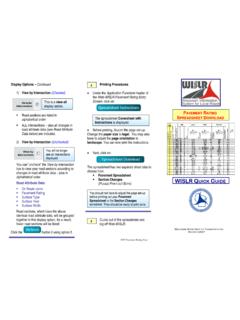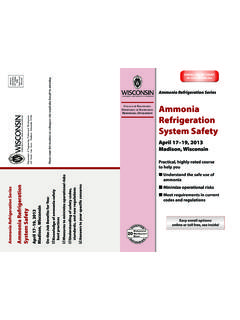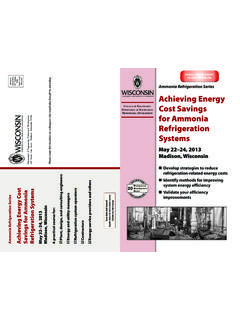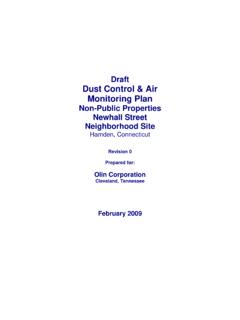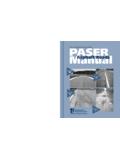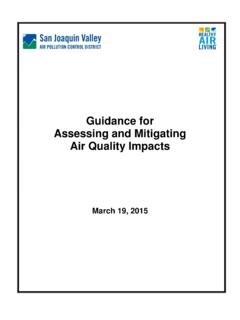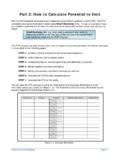Transcription of Dust Control on Unpaved Roads - University of Wisconsin ...
1 Spreading chlorides continued from page 3. Pre-wet the surface with water at rates ranging from Scarify the top one to two inches of the road to Roads with higher traffic volumes usually require Restrictions on asphalt cutbacks and waste oil Wisconsin Transportation Bulletin No. 13. to yd. to reduce surface tension, to loosen the aggregate. Prepare the surface by removing more asphalt for effective dust Control than Roads with Cutback use is restricted in Wisconsin . Medium-curing develop the capillary action that allows maximum potholes and washboards and adding any necessary lower traffic volumes.
2 Roads treated for the first time tend and rapid-curing cutbacks may not be used for any penetration of the dust Control product, and to ensure aggregate or fines. Mix thoroughly scarified materials to require more asphalt than those that have been treated purpose during June, July and August. They may be uniform application. If a dust coat has already developed, using a pulverizer. It may take several passes to break in previous years. Initial seasonal treatments also tend to used for dust Control (or as a prime coat before asphalt regrade and moisten. aggregates down to sizes less than inches.)
3 Moisten require more asphalt than treatments applied later in the surfacing) during May and September. All other uses of Choose dry calcium chloride for smaller applications. the surface with from to yd. of water. same season. these cutbacks are prohibited during these months. The bags are easy to store and the dry material requires Re-mix scarified materials after watering, to ensure Splashing on vehicles which drive over the newly Slow-curing cutbacks are not restricted. less specialized equipment to apply. Store dry calcium optimum moisture content. treated surface can be a drawback to using asphalt for Do not use waste oil for dust Control .
4 Waste oil often chloride covered on an impermeable base. Wisconsin Apply the dust Control agent uniformly. Use longitu- dust Control . Lightly sand, blade, or drag the road after contains harmful contaminants and must be managed as asphalt treatment to prevent this tracking. Use about statutes require proper storage. Liquid calcium chloride, which is less expensive, easier to handle, and easier to dinal blade mixing coupled with rotary mixing by the pulverizer. Add water as necessary. 5 to 10 pounds of sand per square yard of road surface. a hazardous substance under state law. dust Control on Unpaved Roads apply, is best for larger projects.
5 Blade the mixture into a windrow along one edge of Unpaved surfaces can be hardened through succes- sive applications of asphalt over several years. A thin Apply calcium chloride or other agent evenly over the the road , then spread the windrow in two equal lifts. surface layer is built up which reduces dust problems but References and resources Gravel and other Unpaved surfaces can provide road 's surface. The applications should overlap each Each lift should be compacted with a sheepsfoot roller good, economical Roads for low traffic volumes. other by 6 to 12 inches, and should overlap the crown at until the tamping feet walk out.
6 Finally, blade the may make it more difficult to blade and regrade the road . dust Control On Unpaved Roads , MN/RC-9207, by The dust they produce, however, causes air the center of the road which carries the most traffic. mixture for crown and compact it with a rubber-tired If successive applications are planned, apply a total of Chunhua Han, PhD, Braun Intertec Pavement, Inc., pollution, slows plant growth, and damages Follow dry applications with enough water to ensure roller. Allow the mix to cure long enough to prevent to yd. of emulsion or cutback in three prepared for the Minnesota Local road Research Board, the road surface.
7 Although paving is the only that the pellets or flakes are completely dissolved. When excessive pickup from traffic. applications. Use about half the total for the first applica- St. Paul, MN, March 1992, 39 pp. Available through permanent solution to dust problems, using applying liquids, avoid runoff or puddling. Use several tion and divide the remaining amount between the National Technical Information Services, Springfield, effective controls can significantly reduce dust light sprays if the surface is tight. If areas are left uncov- Maintenance for calcium chloride-treated road second and third applications.
8 Leave enough time VA 22161. and can cut required maintenance. ered by poor driving of the distributor, stop and add water During dry periods, water the road periodically to between applications for the road surface to completely Unpaved Roads are the largest source of road dust Suppressants, Vermont Local Roads Program, before beginning to spread again. If penetration is poor, reactivate the chemical's hygroscopic properties. Apply absorb the asphalt. particulate air pollution in the country. Accord- St. Michael's College, Winooski, VT, 802/655-2000. you may need to use a mix-in-place procedure.
9 Water at the rate of to yd. To maintain an asphalt-treated road , patch with cold ing to the Environmental Protection Agency, Allow the treated road to cure up to four hours Usually only a light blading is needed, preferably after mix or hot mix asphalt pavement or gravel. If you use New dust Control Material Proves Itself, June-August Unpaved Roads produce almost five times as until vehicles can drive on the road without picking up a rainfall. Studies show that maintenance can be cut by gravel, it should be coated with asphalt to make it hold to 1995 issue of Milepost, newsletter of the Texas Engineer- much particulate matter as construction treated material on their wheels.
10 Curing may take longer 25% to 75% on calcium chloride-treated Roads . the road surface. ing Extension Service, Local Technical Assistance activities and wind erosion (the next two largest on Roads with finer grained materials. If necessary, The grader should blade lightly from edges toward the Program, Transportation Draining Division, College sources) combined. In addition to polluting the compact the treated area after curing is completed. center and then feather the material back toward the Station, TX. (Reprinted from Technology News, Iowa air, dust can be a health problem for nearby Treat the road a second time before the first one edges.)
